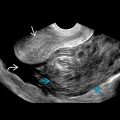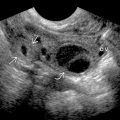KEY FACTS
Imaging
- •
All tumors (benign and malignant) can have variable appearances, a lot of overlap by US
- •
Benign tumors
- ○
Hemangioma: #1 benign splenic tumor; typically small, echogenic, incidental, asymptomatic
- ○
Hamartoma: Typically echogenic, homogeneous
- ○
Lymphangioma: Typically hypoechoic, loculated, avascular; younger age
- ○
Littoral cell angioma: Rare; variable appearance, splenomegaly
- ○
- •
Malignant tumors
- ○
Lymphoma (Hodgkin disease, non-Hodgkin lymphoma, primary splenic, AIDS-related), leukemia, myeloproliferative disorders
- –
Classic: Diffuse SMG; if focal: Hypoechoic, indistinct margins
- –
3 macroscopic patterns: Diffuse/infiltrative, miliary/nodular, focal hypoechoic
- –
- ○
Metastasis (breast, lung, ovary, stomach, melanoma)
- –
Cystic, solid, or mixed; can be targetoid lesions
- –
- ○
Primary splenic malignancies very rare (angiosarcoma most common of these)
- ○
Top Differential Diagnoses
- •
Splenic infarct
- •
Splenic infection/abscess
- •
Splenic cyst
- •
Splenic hematoma
- •
Hepatosplenic sarcoidosis
Diagnostic Checklist
- •
Primary splenic malignancies are rare; biggest diagnostic dilemma is usually indeterminate splenic lesion in patients with extrasplenic malignancy (i.e., is it metastasis or not)
- •
Considerable overlap in US findings; reliable differentiation on imaging is not always possible, requires histology
Scanning Tips
- •
Color Doppler vascularity may be helpful if present (to conclude not cyst), but absent color flow does not entirely exclude benign or malignant tumor
- •
Isolated splenic metastases and primary splenic malignancies are rare; most splenic metastases are seen in setting of widespread metastatic disease, including liver
 and peripheral hypoechogenicity
and peripheral hypoechogenicity  (target-like pattern).
(target-like pattern).
 , confirming its solid (not cystic) nature.
, confirming its solid (not cystic) nature.
 . Also note the presence of peritoneal soft tissue implants along the surface of the liver
. Also note the presence of peritoneal soft tissue implants along the surface of the liver  .
.
Stay updated, free articles. Join our Telegram channel

Full access? Get Clinical Tree








